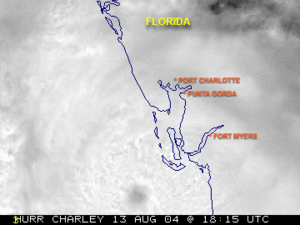Landfall (meteorology) facts for kids
Landfall is when a tropical cyclone (like a hurricane or typhoon) or a waterspout moves from being over water to being over land. It's a big moment for these storms.
When a waterspout that's like a tornado reaches land, it becomes a tornado. It can cause a lot of damage to buildings and other things people have built. A 'fair weather' waterspout is weaker. When it hits land, it quickly breaks apart. The water just falls as rain.
A tropical cyclone makes landfall when its center, or 'eye,' moves from the ocean onto land. This is usually when the most damage happens. While a storm is over water, it mostly affects the ocean. But if parts of the storm are raining over land, it can cause serious flooding. This is especially true if the storm is moving slowly or not at all.
What Happens During Landfall?
When a tropical cyclone makes landfall, several important things happen:
- The storm surge (a rise in sea level) reaches its highest point.
- The strongest winds from the storm move onto shore.
- Heavy, flooding rains begin to fall over land.
These effects, along with high surf, can cause a lot of beach erosion. In low-lying areas, the storm surge can stay inland for a long time. It might even mix with chemicals already in the area, creating a dangerous mess.
After a tropical cyclone makes landfall, its eye often "closes" or becomes less clear. The high surf usually calms down. The winds also get weaker as the cyclone spreads out and loses its energy. Damage further inland can include heavy rains that cause floods, strong winds, and severe weather from the storm's remaining thunderstorms.
Landfall vs. Direct Hit
It's important to know the difference between a "landfall" and a "direct hit." A "direct hit" happens when the core of the storm's strongest winds, called the eyewall, comes over the land. But the very center of the storm (the eye) stays over the water.
The effects of a direct hit are similar to landfall, but the storm surge is often much less. Here's what can happen during a direct hit:
- High surf along the coast.
- Heavy rains that cause flooding.
- Water building up along the coast.
- Smaller storm surges.
- Beach erosion.
- Strong winds.
- Possibly severe weather.
Images for kids
-
Hurricane Maria losing its shape after making landfall in Puerto Rico.
See also
 In Spanish: Aterrizaje (meteorología) para niños
In Spanish: Aterrizaje (meteorología) para niños





